In the world of shaving, the safety razor has stood the test of time as a timeless, efficient, and eco-friendly choice for a close shave. However, selecting the perfect safety razor can be a daunting task with a wide range of options available. In this comprehensive guide, we will walk you through the nuances and intricacies of choosing the best safety razor. Whether you're a seasoned pro or new to the world of wet shaving, this article has got you covered.
Initially, safety razors look to be a very simple shaving tool. However, there are made from various parts, and understanding those parts can make a really big difference to your overall shaving experience. If you are someone who likes to know the details before making a purchase, then this guide explains everything to do with choosing safety razors.
We will include the various types of safety razor, the features and benefits of each type, safety razor blade options. It also includes the key factors you should think about in terms of your skill level, skin type, ongoing maintenance of the razor and your budget.
Exploring Safety Razors: The Basics
What is a Safety Razor?
A safety razor, often known as a double-edge razor, is a shaving tool designed to provide a safe and effective way to remove facial or body hair.
It features a handle which can vary in length and these handles can have different grips.
The head typically has a protective guard that surrounds the sharp blade, minimising the risk of nicks and cuts while allowing for a close shave.
It may also have what is known as a comb which offers the skin protection from the blade.
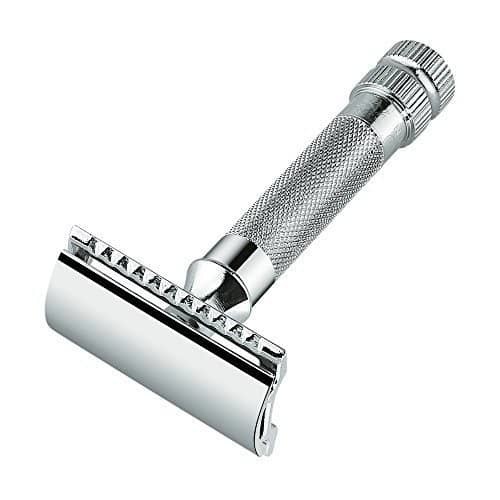
Safety razors use a razor blade, which needs to be regularly replaced. The way the safety razor opens up to do this can also be slightly different. Safety razors can be made from different materials.
Understanding the various types of safety razors, from the classic double-edge to adjustable razors, is essential for making an informed choice. Each type of safety razor has its own advantages and may be preferred by different users based on their shaving needs and personal preferences. The choice of a safety razor depends on factors like shaving experience, hair type, skin sensitivity, and desired maintenance level.
Key Features to Consider Before Buying a Safety Razor
The key things to understand are:
- What type of safety razors are available on the UK market?
- How do those safety razors open as that is how you change the razor blade which you will need to do every few days?
- What razor blade types are available and what is the difference?
- What are safety razor combs and why do they matter
- What materials are safety razors made from and why that matters?
- What handle lengths and type of handles are available and why that matters?
1. Main Types of Safety Razor
There are 8 main types of safety razor:
- Two-Piece Safety Razor: A two-piece razor consists of a handle and a top plate that holds the blade. It's simple to use and provides excellent control. Most of these make use of what is called a butterfly option, which is a simple twisting action to open the razor and allow for simple blade changing.
- Three-Piece Safety Razor: The three-piece design comprises a handle, top plate, and baseplate. The handle has a threaded end that allows you to screw it onto the baseplate. To assemble the razor, you simply screw the handle into the baseplate/top cap, sandwiching the razor blade in between. This design allows for quick and easy blade changes without having to disassemble multiple parts. This design offers precision and is favored by many wet shaving enthusiasts.
- Adjustable Safety Razor: These are used by more experienced wet shavers. You can adjust the gap by small amounts between the blade and the top plate. That can determine the depth of cut. This depth is also known as the aggressiveness of the cut.
- Slant-Bar Razor: Has a slanted blade exposure, which cuts hair at a slight angle. Known for being more efficient at cutting coarser or thicker beard hair. Like the adjustable type, this slant type tend to be used by highly experienced safety razor uses, after they have used other simpler models first and for a long time.
- Cartridge-Compatible Safety Razor: Designed to hold disposable cartridge razor heads. Provides the convenience of cartridge razors with the aesthetics of a traditional safety razor. There are not many of these around.
- Sliding Blade Razor: Has a mechanism that allows you to slide the blade forward or backward. You can adjust the blade exposure for a customized shave.
- Vintage or Antique Razors: Refers to safety razors that were produced in the past and are now considered collectibles. They often have unique designs and materials. These tend to be bought by collectors.
- Travel Safety Razor: Compact and designed for portability. Some have a two-piece design for easy storage in a travel case.
1. Two Piece Safety Razor

A 2-piece safety razor is a type of safety razor with a specific design that consists of two main components: the handle and the top cap/baseplate. This design is in contrast to the more common 3-piece safety razors, which have three components: the handle, baseplate, and a separate top cap.
Here's how a 2-piece safety razor typically works:
- Handle: This is the part you hold while shaving. It usually has a threaded end that allows you to screw it onto the second component, the baseplate.
- Baseplate/Top Cap: In a 2-piece design, these two parts are often combined into one piece, forming the top section of the razor head. The baseplate provides the platform on which the razor blade sits, and the top cap holds the blade securely in place.
To assemble the razor, you simply screw the handle into the baseplate/top cap, sandwiching the razor blade in between. This design allows for quick and easy blade changes without having to disassemble multiple parts.
2-piece razors are popular among wet shavers for their simplicity and ease of use. While they may not be as compact for travel as some 3-piece razors, they are often considered more convenient for daily shaving because of their minimal setup and blade replacement process. They offer a secure and snug blade fit, ensuring a precise and comfortable shave.
Two popular two-piece safety razors are:
- Merkur 34C HD: - Merkur is a well-known brand in the world of safety razors, and the Merkur 34C HD is one of their most iconic models. It features a two-piece design, making it easy to change blades. The 34C HD is known for its excellent build quality, balance, and comfortable shaving experience.
- Parker 99R: - The Parker 99R is another two-piece safety razor that has gained popularity among wet shavers. It's known for its heft and balance, making it an attractive option for those who prefer a slightly heavier razor. The butterfly-style twist-to-open mechanism on this razor simplifies blade replacement.
2. Three Piece Safety Razor
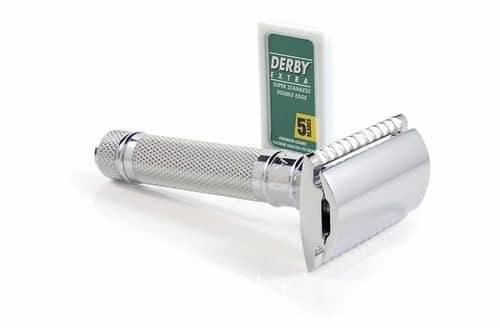
A 3-piece safety razor is a type of safety razor that consists of three main components: the handle, the baseplate, and the top cap. This design is one of the most common and traditional configurations for safety razors. Here's how a 3-piece safety razor typically works:
- Handle: The handle is the part of the razor that you hold while shaving. It often has a threaded end that allows you to screw it onto the baseplate.
- Baseplate: The baseplate is the piece that provides the platform on which the razor blade sits. It typically has posts or guides that help align and secure the blade in place.
- Top Cap: The top cap is a separate piece that fits over the blade and baseplate, completing the razor head. It holds the blade securely in place and helps control the blade's angle and exposure during shaving.
To assemble a 3-piece safety razor, you screw the handle into the baseplate, sandwiching the razor blade between the baseplate and the top cap. This design offers more versatility in terms of adjusting the razor's aggressiveness by changing the blade angle or exposure. It also allows for thorough cleaning and maintenance because all the components can be easily disassembled.
Many wet shavers appreciate 3-piece safety razors for their durability, simplicity, and the ability to customize the shaving experience by changing blades and adjusting the razor's components.
Two popular 3-piece safety razors are:
- Edwin Jagger DE89: - The Edwin Jagger DE89 is a popular three-piece safety razor known for its excellent craftsmanship and shaving performance. It features a classic design and is available in various handle materials and finishes. This razor is often recommended for both beginners and experienced wet shavers.
- Mühle R89: - The Mühle R89 is another highly regarded three-piece safety razor. Mühle, a German company, is known for its precision engineering and high-quality razors. The R89 offers a balanced and mild shaving experience, making it suitable for those with sensitive skin.
3. Adjustable Safety Razor
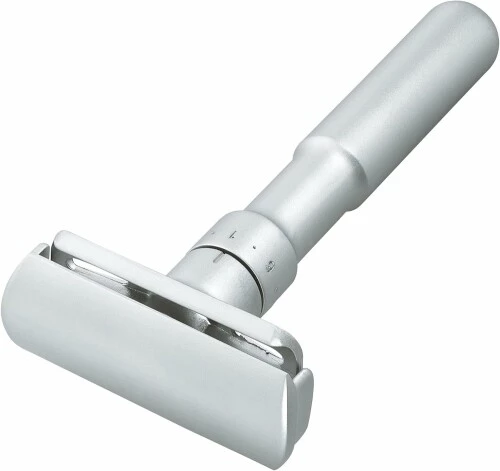
An adjustable safety razor is a type of safety razor with a unique feature that allows the user to adjust the razor's blade exposure and angle during shaving. This adjustability gives the shaver more control over the aggressiveness of the shave, making it a versatile choice for different hair types and shaving preferences.
The key features of an adjustable safety razor include:
- Blade Exposure: Adjustable safety razors typically have settings that allow you to control how much of the razor blade is exposed. Increasing the blade exposure results in a more aggressive shave, while reducing it provides a milder shave. This feature lets you tailor the razor's cutting efficiency to your specific needs.
- Blade Angle: Some adjustable razors also allow you to adjust the angle at which the blade contacts the skin. A more acute angle can provide a closer shave, while a less aggressive angle is gentler on the skin.
- Shaving Customisation: The ability to adjust both the blade exposure and angle means you can fine-tune the razor to your liking, which is particularly useful for those with different beard types or varying levels of sensitivity.
Adjustable safety razors are favored by experienced wet shavers because they offer more control and versatility in achieving the desired shaving results. However, they may have a steeper learning curve for beginners, as it's important to find the right settings for your specific needs.
Some well-known adjustable safety razors include the Merkur Futur and the Rockwell 6C/6S, which offer multiple settings to cater to various preferences.
4. Slant Bar Safety Razor
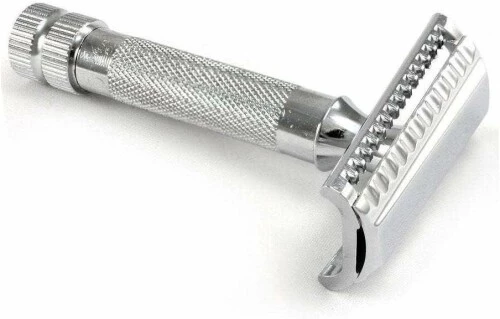
A slant bar safety razor, often referred to as a slant razor, is a type of safety razor with a unique head design where the razor blade is slanted, typically at an angle between 10 to 30 degrees. This slanted configuration sets slant razors apart from the more common straight-bar or open-comb safety razors.
The key features of a slant bar safety razor include:
- Slanted Blade: The blade in a slant razor is torqued or bent to create a diagonal or slanted cutting edge. This design provides a different approach to cutting hair compared to the flat blade exposure in standard safety razors.
- Efficiency: Slant razors are known for their cutting efficiency, making them particularly effective at slicing through coarse or thick beard hair. The slanted blade reduces the cutting resistance, allowing for a smoother shave with fewer passes.
- Smooth Shaving Experience: Despite their efficiency, slant razors are often considered gentler on the skin than aggressive straight-bar razors, as they minimize tugging and pulling.
- Reduced Clogging: The slanted design also helps prevent the razor from clogging with hair and shaving cream, ensuring a consistent and uninterrupted shaving experience.
Slant bar safety razors are popular among wet shaving enthusiasts who have thicker or coarser facial hair, as well as those seeking a close and comfortable shave. However, they may require a bit of adjustment if you're transitioning from a traditional straight-bar safety razor, as the shaving technique can be slightly different due to the slanted blade.
Some well-known slant razors include the Merkur 37C and the iKon X3 Slant.
5. Cartridge-Compatible Safety Razor
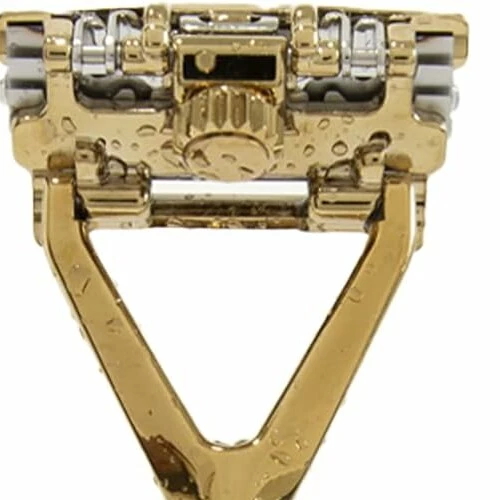
A cartridge compatible safety razor is a type of safety razor that is designed to hold disposable cartridge razor heads. It's a hybrid razor that combines the traditional aesthetics and handling of a safety razor with the convenience of modern cartridge razors. These razors are also known as "system razors" because they allow you to use both disposable cartridge heads and traditional double-edge (DE) blades.
The key features of cartridge-compatible safety razors includes:
- Interchangeable Heads: The razor has a mechanism that allows you to switch between different shaving heads. You can use a cartridge head for a quick and convenient shave or attach a DE head for a more traditional wet shaving experience.
- Versatility: These razors offer versatility in terms of the type of shaving experience you want. You can choose between a quick, no-fuss shave with a cartridge head or a more precise, traditional shave with a DE blade.
- Safety and Comfort: The use of DE blades can offer a close and comfortable shave, while the cartridge heads often come with features like lubricating strips and multiple blades for added comfort.
- Economical: Using DE blades can be more cost-effective in the long run compared to continuously purchasing disposable cartridges.
- Environmental Considerations: Some people choose cartridge-compatible razors as a more environmentally friendly option since they can reduce the waste associated with disposable cartridges.
Cartridge-compatible safety razors cater to individuals who appreciate the best of both worlds: the convenience and ease of cartridge razors and the precision and customization of traditional wet shaving with DE blades. These razors are ideal for those who want to transition from disposable cartridges to DE blades gradually.
Notable brands in this category include the Parker Variant Multi-Head Razor and the Leaf Shave Razor. There are not a great deal of choices and not a popular choice for many buyers.
6. Sliding Blade Safety Razor
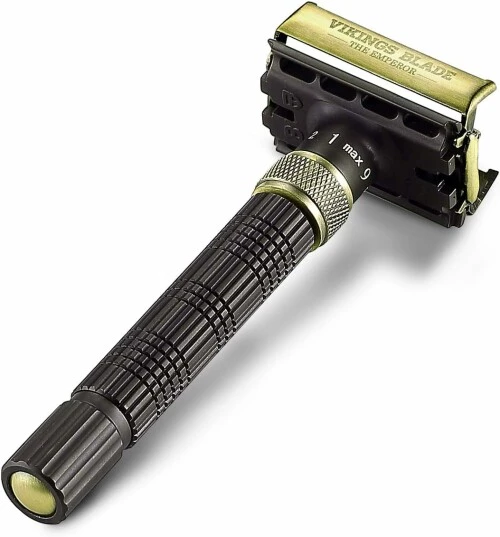
A sliding blade safety razor is a type of safety razor that features a unique mechanism that allows you to adjust the position of the razor blade within the razor head. This adjustment gives you control over the blade's exposure, essentially customizing the razor's aggressiveness to your shaving preference.
The key features of a sliding blade safety razor includes:
- Blade Position Control: The razor head of a sliding blade razor has a mechanism that lets you move the blade assembly forward or backward within the head. This adjustment changes the gap between the blade and the safety bar, thereby altering the aggressiveness of the shave.
- Customisable Shaving Experience: The ability to adjust the blade's position allows you to achieve a more aggressive or milder shave, depending on your needs and preferences. This customization is particularly useful for individuals with different beard types and skin sensitivities.
- Smooth and Close Shave: Sliding blade razors can provide a smooth and close shave, making them a popular choice among wet shaving enthusiasts who desire precision and control.
- Learning Curve: These razors may have a bit of a learning curve, as you'll need to experiment with the blade position to find the setting that works best for you. However, once you've found the right setting, you can enjoy a highly personalized shaving experience.
Sliding blade safety razors are valued for their flexibility and the ability to cater to various shaving requirements.
Brands like the Rex Ambassador Adjustable Safety Razor are known for their sliding blade mechanism, allowing users to fine-tune the razor's aggressiveness to their liking.
7.Vintage or Antique Safety Razors
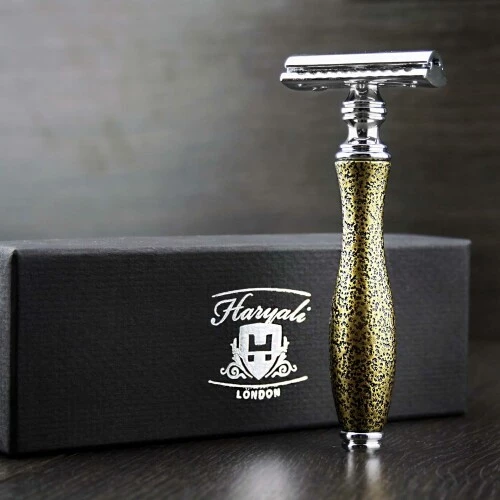
Vintage or antique safety razors are safety razors that were manufactured in the past and are no longer in production as new items. These razors are considered collectibles due to their historical significance and unique designs. They hold a special place in the world of wet shaving, and many enthusiasts and collectors seek them out for various reasons.
Key features and characteristics of vintage or antique safety razors include:
- Historical Significance: Vintage razors often have historical value, as they may be associated with specific time periods or manufacturers from the past. They can be artifacts of a bygone era.
- Unique Designs: Vintage razors come in a wide range of designs, materials, and finishes. Some feature ornate handles, intricate engravings, and various types of craftsmanship that reflect the style and aesthetics of the era in which they were produced.
- Variety of Materials: These razors can be made from materials such as brass, stainless steel, silver, and even precious metals like gold or platinum, depending on their age and rarity.
- Collectibility: Many wet shaving enthusiasts collect vintage razors for their historical and aesthetic appeal. Some razors are highly sought after and can become valuable collector's items.
- Quality Craftsmanship: Vintage razors often exhibit high-quality craftsmanship, which can result in excellent shaving performance. They may have been built to last, and some can still provide a great shave even after many decades.
- Availability: The availability of vintage razors can vary, and some models may be quite rare, while others are more commonly found in the vintage market.
While vintage or antique safety razors can be a delightful addition to a shaving collection, it's important to note that they may require additional care, maintenance, and sometimes restoration to be in optimal shaving condition. Additionally, not all vintage razors are suitable for regular use, as some may have become collectibles due to their rarity or historical value. Collectors often appreciate these razors for their uniqueness and the nostalgia they evoke.
8.Travel Safety Razors
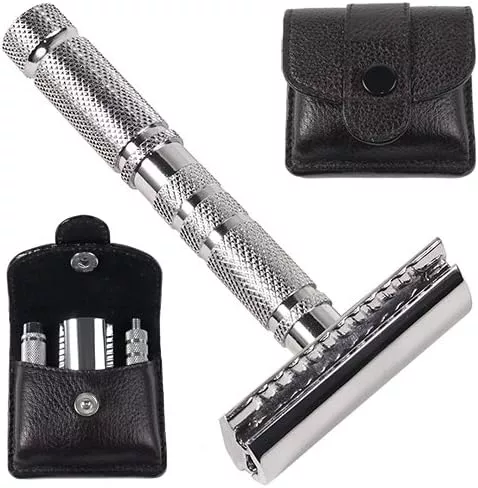
A travel safety razor is a compact and portable safety razor designed specifically for use while traveling. These razors are built with features that make them convenient for individuals who need to maintain their grooming routine on the go. Travel safety razors are typically smaller, lightweight, and easy to pack in luggage, making them an ideal choice for travelers.
Key features and characteristics of travel safety razors include:
- Compact Size: Travel razors are designed to be smaller and more portable than standard safety razors. They often have a shorter handle and a more compact razor head.
- Lightweight Construction: To reduce the overall weight of your travel gear, these razors are typically made from lightweight materials such as aluminum or plastic.
- Dismantlable Design: Many travel razors have a two- or three-piece design that allows you to easily disassemble the razor for compact storage in a travel case.
- Travel Cases: Travel razors often come with protective travel cases or pouches to keep the razor and blades safe during transit. These cases are designed to fit easily into toiletry bags or luggage.
- Blade Compatibility: Some travel razors are compatible with both double-edge (DE) razor blades and cartridge razor heads, offering flexibility in blade choices while traveling.
- Versatility: Despite their small size, travel safety razors aim to deliver a comfortable and effective shaving experience, similar to standard safety razors.
- Durable Materials: While lightweight, travel razors are typically constructed from durable materials to withstand the rigors of travel.
Travel safety razors are an excellent choice for individuals who want the convenience of wet shaving while on the road, whether for business or leisure travel. These razors allow you to maintain your grooming routine and achieve a close, comfortable shave, even when you're away from home.
Many well-known razor manufacturers offer travel safety razors as part of their product lines. The Mühle R89 Twist is a compact and travel-friendly version with a twist-to-open (TTO) mechanism for easy blade replacement and a shorter handle for portability.
Another well known one is the Parker 91R Ultra Compact Travel Razor. That has been designed specifically for travelers and features a compact, two-piece design. It comes with a leather case for protection and easy packing in your travel kit. It takes standard double-edge (DE) razor blades, providing a smooth shaving experience while maintaining travel convenience.
2. Safety Razor Openings
There are 2 main ways of opening a safety razor to change the blade:
- A butterfly option also known as Twist to Open (TTO)
- Three Piece Opening
1. Butterfly or Twist-to-Open (TTO) Razor
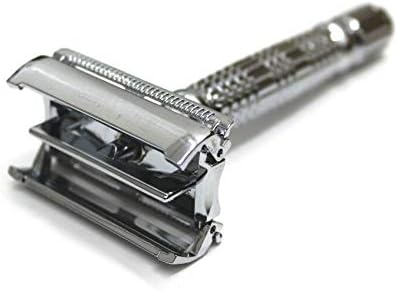
Features a hinged head that opens like butterfly wings. This design makes it easy to replace the blade by simply twisting the handle. When you twist the handle of a butterfly or TTO razor, it causes the two hinged doors on the razor head to open up like butterfly wings. This exposes the blade compartment.
With the razor head open, you can insert a new razor blade by placing it between the doors. Once the blade is in position, you simply twist the handle in the opposite direction to close the doors, securely holding the blade in place. The doors of the razor head lock into position, ensuring that the blade is properly aligned for shaving.
The butterfly or TTO design is known for its convenience because it eliminates the need to disassemble the razor into multiple parts to change the blade, as is common with three-piece safety razors. This feature simplifies the blade replacement process and is especially appreciated by individuals who prefer a quick and straightforward way to maintain their razors.
It's worth noting that butterfly razors are often recognised by their distinctive appearance, with the hinged doors on the razor head that resemble butterfly wings.
2. Three Piece Opening Safety Razor

A "3-piece opening" refers to the design of a particular type of safety razor, which consists of three separate components that can be disassembled to change the razor blade. Here's how the 3-piece opening safety razor works:
- Handle: The handle is the part you hold while shaving. It typically has a threaded end.
- Baseplate: The baseplate is a flat piece with posts or guides that hold the razor blade in place. It attaches to the handle by screwing it onto the threaded end.
- Top Cap: The top cap is the final component, and it fits over the baseplate, securing the razor blade in between. It completes the razor head assembly.
To open or disassemble the 3-piece razor, you unscrew the handle from the baseplate, separating the three components. This allows you to replace the razor blade easily. After changing the blade, you reassemble the razor by reattaching the baseplate and screwing it back onto the handle.
3-piece razors are known for their simplicity and ease of maintenance. They offer a secure and snug fit for the blade, ensuring a precise and comfortable shave. While they may require a bit more time to change the blade compared to butterfly or twist-to-open razors, many wet shavers appreciate the control and customization that 3-piece razors offer.
3. Safety Razor Blade Types
There are 2 main ways of opening a safety razor to change the blade:
- Double-Edge Safety Razor (DE Razor): The most popular and widely used type. It has a single, double-edged blade that is inserted into the razor head. DE razors are known for their close and precise shaving.
- Single-Edge Safety Razor (SE Razor): Similar to DE razors, but they use a single-edged blade. Blades for SE razors are thicker and typically longer-lasting than DE razor blades.
4. Safety Razor Combs
There are 2 comb types available on a safety razor blade:
- Open-Comb Razor: Features teeth or combs on the safety bar that guide the hair to the blade. Suitable for those with longer or thicker facial hair.
- Closed-Comb Razor: The safety bar has a solid, closed design. Offers a slightly milder shave compared to open-comb razors.
5. What materials are safety razors made from and why that matters?
Safety razors are typically made from a variety of materials, each with its own set of characteristics and benefits. The choice of materials can impact the razor's performance, durability, and overall quality. Here are common materials used in safety razors and why they matter:
- Stainless Steel: - Stainless steel razors are highly durable and resistant to corrosion, making them a popular choice.
They are known for their longevity, and many consider them a lifetime investment.
Stainless steel razors have a solid, substantial feel, which can provide a comfortable and balanced shave. - Brass: - Brass razors are known for their excellent weight and balance, providing a smooth shaving experience.
They are often plated with other materials like chrome, nickel, or gold to enhance their aesthetics and protect against corrosion. - Aluminum: - Aluminum razors are lightweight and easy to maneuver, which can be especially advantageous for beginners.
They are less prone to rust but may be more susceptible to scratching or dents compared to stainless steel or brass. - Zinc Alloy: - Zinc alloy razors are often more affordable than those made from premium materials.
While they may not be as durable as stainless steel or brass, they can still provide a satisfactory shaving experience. - Titanium: - Titanium razors are lightweight, highly corrosion-resistant, and extremely durable.
They are known for their premium quality and long lifespan but can be more expensive. - Plastic and Resin: - Some budget-friendly razors have plastic or resin components, such as the handle.
While these materials may not be as durable as metal, they can still be effective for occasional use and travel.
The choice of material matters for several reasons:
- Durability: The material affects how long the razor will last. Stainless steel, brass, and titanium razors are known for their durability and long-term performance.
- Weight and Balance: The material influences the weight and balance of the razor. This can impact the shaving experience and ease of use. Heavier razors may provide a smoother shave due to their weight, while lighter razors are more maneuverable.
- Corrosion Resistance: Some materials are more resistant to rust and corrosion, which is crucial for the razor's longevity and maintenance.
- Aesthetics: The material can affect the razor's appearance. Some people prefer the classic look of metal razors, while others may appreciate the variety of finishes and colors available with different materials.
- Cost: The choice of material can significantly impact the cost of the razor. Premium materials like stainless steel and titanium tend to be more expensive, while zinc alloy and plastic razors are often more budget-friendly.
Ultimately, the choice of material should align with your shaving preferences, budget, and the level of maintenance you're willing to undertake. Quality and craftsmanship also play a crucial role in a razor's overall performance, so it's essential to consider these factors in addition to the material when selecting a safety razor.
6. What handle lengths and type of handles are available and why that matters?
The handle length and grip are crucial factors for a comfortable and controlled shave. We discuss the different handle designs and their influence on your shaving experience.
Handle Lengths:
Safety razors come in various handle length sizes to accommodate the preferences and needs of different users. The standard handle length for most safety razors falls within the range of 3 to 4 inches (approximately 7.5 to 10 centimeters). However, some safety razors may have shorter or longer handles. Here are some common handle length options and their characteristics:
Short Handle
(Approximately 2.5 to 3 inches)
Short-handled safety razors are more compact and lightweight.
They are often favored by travelers or those who prefer a more maneuverable razor.
Short handles are ideal for shaving in tight spaces or for users with smaller hands.
One short handled safety razor is the Merkur 15C
Standard Handle
(Approximately 3 to 4 inches)
The standard handle length is the most common and versatile option.
It strikes a balance between control and comfort, making it suitable for most users.
The majority of safety razors available have handles within this range
One standard handled safety razor is the Merkur 15C
Long Handle
(Approx 4.5 to 5 inches or longer)
Long-handled safety razors are preferred by individuals who appreciate the added reach and grip.
They are often chosen by users who want more control or those with larger hands.
The extra length can be advantageous for users who need to shave in hard-to-reach areas.
One log handle safety razor is the Mühle R106 Long-Handled Safety Razor.
Handle Grips:
Safety razors come with a variety of grip designs to provide users with different options for a secure and comfortable hold. The choice of grip type is often a matter of personal preference. Here are some common types of grip patterns and designs available on safety razors:
- Knurled Grip: Knurling is a textured pattern of fine, diamond-shaped or straight-line grooves that is applied to the handle. It provides a firm and non-slip grip, making it one of the most popular grip styles.
- Crosshatch Grip: Crosshatch patterns are a series of intersecting lines or squares on the handle, creating a textured surface that enhances grip and control.
- Barber Pole Grip: This design resembles a traditional barber pole, with spiraling bands around the handle. It offers both an attractive appearance and a functional grip.
- Fluted Grip: Fluting involves vertical or diagonal grooves cut into the handle. It provides an aesthetically pleasing design while ensuring a secure grip.
- Smooth Handle: Some razors have smooth handles without any specific texture or pattern. While they may not offer the same level of grip as textured handles, some users prefer the minimalist look and feel.
- Diamond Knurl Grip: This type of grip consists of small diamond-shaped patterns that provide an effective non-slip surface.
- Ridges and Rings: Some handles have ridges or rings that encircle the handle, providing tactile feedback for a secure hold.
- Ribbed Grip: Ribbed handles have parallel ridges running along the length of the handle, offering a comfortable and easy-to-grip surface.
- Wavy Grip: Wavy patterns on the handle consist of curving lines or waves, which can add a touch of style to the design while enhancing grip.
- Ergonomic Handles: Some safety razors are designed with ergonomic contours that fit comfortably in the hand, offering a natural and secure grip.
The choice of grip design depends on your personal preference and the level of control and comfort you desire during shaving. Different users may find specific grip patterns more suitable based on the size of their hands, shaving techniques, and personal aesthetics. Ultimately, the ideal grip design is the one that provides a secure and pleasant shaving experience for you.
Safety Razor Blade Options
There are two types of razor blades used in shaving:
- Double Edge blades (DE)
- Single Edge blades (SE)
Single edge blades are primarily used for straight razors (cutthroat razors). Most safety razors will use a standard razor blade with two edges. There are many brands who sell these, and they come in a variety of metals. Stainless steel remains the most popular. They are made by brands such as Astra, Derby, Feather, King C Gillette, The Shave Factory, Lord Merkur, Muhle etc.
Typically they are sold in packs and are relatively cheap. You can read more about the best safety razor blades for safety razors by clicking here.
Factors for Choosing the Best Safety Razor
Your Skill Level
When buying a safety razor, it's important to consider your skill level and experience in wet shaving, as different razors are better suited to various skill levels. Here are the skill levels to consider when purchasing a safety razor:
Beginner Skill Levels:
- Mild Razors: Beginners should look for mild and forgiving safety razors. These razors are less aggressive and are less likely to cause nicks and irritation.
- Closed Comb Design: Razors with closed comb designs are typically easier for beginners to use. They provide added protection and reduce the risk of cuts.
Intermediate Skill Level:
- Adjustable Razors: Intermediate shavers who have gained some experience can explore adjustable safety razors. These razors allow you to fine-tune the aggressiveness to your preference.
- Open Comb or Slant Bar: Some intermediate shavers may want to try open comb or slant bar razors, which provide a different shaving experience with more blade exposure and efficiency.
- Advanced Skill Users:
Open Comb or Slant Bar: Advanced shavers often appreciate the precision and efficiency of open comb and slant bar razors. These designs require a higher skill level but can provide a very close shave. - Straight Razors: Straight razors, while not technically safety razors, are an advanced option for those seeking the closest and most traditional shaving experience. They require skill in stropping and honing.
Expert Skill Level:
- Single-Edge Razors: Expert wet shavers may explore single-edge safety razors (SE) or injector razors, which offer a unique shaving experience and require a high level of skill.
- Blade Banks: Experts often use blade banks or disposal containers to safely store used razor blades.
All Skill Levels:
- Two-Piece and Three-Piece Razors: Two-piece and three-piece razors can be suitable for all skill levels. Their design allows for versatility and customization by changing the blade and adjusting the angle.
- Blade Sampler Packs: Regardless of your skill level, it's a good practice to try various blade brands and types to find the ones that work best for you. Blade sampler packs are a valuable resource for all shavers.
Your skill level will impact the type of safety razor that suits you best. Novices should focus on ease of use and safety, while experienced shavers may want to explore more advanced and customizable options. As you gain experience, you can adjust your razor choice to match your growing skill level and shaving preferences.
Skin Type and Sensitivity
Understanding your skin type and sensitivity is pivotal in selecting the best safety razor. We offer guidance on choosing razors that cater to sensitive or normal skin.
Sensitive Skin:
- Mild Razors: If you have sensitive skin, you'll generally want to opt for milder safety razors. These razors are less aggressive, providing a gentler and more forgiving shave to reduce the risk of irritation and razor burn.
- Closed Comb Razors: Closed comb razors are typically better for sensitive skin as they offer additional protection, making them less likely to cause nicks and cuts.
- Adjustable Razors: Some adjustable razors allow you to start with a mild setting and gradually increase the aggressiveness as you become more comfortable with the razor, accommodating sensitive skin.
Normal or Combination Skin:
- Individuals with normal or combination skin have more flexibility in choosing a safety razor. They can use a mild or moderately aggressive razor depending on their preferences and the specific areas they are shaving.
Oily Skin:
- Oily skin can benefit from razors that provide an efficient shave, as excess oils can make the skin more slippery during shaving. Open comb razors or more aggressive options can help provide a close shave for those with oily skin.
Dry Skin:
- If you have dry skin, a mild razor may be more comfortable as it reduces the likelihood of further irritation. Proper pre-shave preparation and the use of moisturizing products are also essential for those with dry skin.
Coarse or Thick Beard Hair:
- Coarse or thick beard hair often benefits from razors that offer efficiency. While these razors can be more aggressive, they allow for a smoother and quicker shave.
Beard Growth Patterns:
- Consider your beard's growth patterns when choosing a safety razor. Some razors are better at handling specific areas, like the neck, where hair grows in various directions.
Personal Preference:
- Ultimately, personal preference plays a significant role. Some individuals with sensitive skin may prefer to use a mild razor, while others with the same skin type may find moderate or aggressive razors suitable. Experimentation with different razors and blade brands is often necessary to find the perfect match for your skin type and sensitivity.
It's important to remember that everyone's skin is unique, so the ideal safety razor may vary from person to person. Proper technique, a good pre-shave routine, and post-shave care are equally essential in achieving a comfortable and irritation-free shave, regardless of your skin type and sensitivity.
Different beard types require different razors. Learn which razor complements your facial hair, whether it's fine, coarse, or thick.
Maintenance and Cleaning
Maintenance and cleaning are essential considerations when choosing a safety razor, as they can impact the longevity and performance of the razor. Here's how maintenance and cleaning can affect your choice of a safety razor:
- Ease of Cleaning - Some safety razors have more complex designs with intricate parts, while others have simpler constructions. Razors with fewer parts and open designs are often easier to clean thoroughly.
- Material Durability - The materials used in the construction of the safety razor can influence its durability and resistance to corrosion. Stainless steel and brass razors are known for their longevity and ease of maintenance, as they are less prone to rust and tarnish.
- Blade Changes - The ease of changing blades is an important aspect of maintenance. Razors that allow for straightforward blade replacement can save time and effort. For example, twist-to-open (butterfly) razors simplify the process.
- Rust Resistance - If you live in a humid environment or don't have a dry place to store your razor, rust resistance becomes crucial. Stainless steel razors are often preferred for their resistance to corrosion.
- Regular Cleaning Routine- Some razors may require more diligent cleaning routines to prevent the buildup of soap scum, lather residue, and hair. Razors with intricate designs, nooks, or crannies may be more challenging to clean.
- Materials for Cleaning - The choice of materials for cleaning, such as ultrasonic cleaners or razor-specific cleaning products, can impact maintenance. Some materials are gentler on the razor's finish and components.
- Long-Term Maintenance - Over time, even the most well-maintained razors may require maintenance to keep them in optimal condition. For some razors, this may involve periodic disassembly, cleaning, and reassembly. Razors that are easier to disassemble may be more convenient for long-term maintenance.
- Storage Considerations - Storing your razor properly can prevent damage and corrosion. If you don't have a safe place to store your razor, choosing a material that is less prone to rust is advisable.
- Maintenance Frequency - The frequency at which you plan to perform maintenance, like disassembling and cleaning the razor, can influence your choice of a razor. Razors with simpler designs may require less frequent maintenance.
Overall, the ease of cleaning, materials used, and the maintenance requirements should align with your preferences and willingness to invest time and effort into caring for your safety razor. Regular cleaning, drying, and proper storage can extend the life and performance of your razor, regardless of its design and materials.
Budget Considerations
Budget considerations can significantly impact your choice of a safety razor, as safety razors come in a wide price range, making them accessible to individuals with varying budgets. Here's how budget considerations can influence your choice of a safety razor:
- Affordability - The most direct impact is on the affordability of the razor itself. Safety razors vary in price, and you can find options that fit within almost any budget, from budget-friendly to luxury razors.
- Long-Term Savings - Safety razors can provide long-term savings compared to disposable razors and cartridges. While the initial investment in a quality safety razor may be higher, the ongoing cost of replacement blades is generally lower, making it a cost-effective choice over time.
- Materials and Finish - Budget considerations may affect the materials and finish of the safety razor. Higher-end razors often feature premium materials like stainless steel or brass, while more budget-friendly options may use chrome-plated or zinc alloy materials.
- Included Accessories - Some safety razors come with additional accessories, such as a stand or a carrying case. Budget razors may not include as many extras, while higher-end models might offer more comprehensive kits.
- Brand and Model - The brand and specific model of the safety razor can impact the price. Recognized brands with a reputation for quality may command a higher price. Budget-friendly options may come from lesser-known brands.
- Used or Vintage Razors -Some individuals choose to buy used or vintage safety razors, which can be more budget-friendly. These razors often require more thorough cleaning and maintenance but can be an economical way to access quality shaving tools.
- Blades and Accessories - Budget considerations can also extend to the ongoing cost of razor blades, shaving cream, and other shaving accessories. Be sure to factor these expenses into your budget when choosing a safety razor.
- Warranty and Customer Support - High-end razors may come with more extensive warranties and customer support. Budget razors may offer more limited warranty coverage.
How to Use a Safety Razor
Using a safety razor is not just about the razor itself but also about the overall shaving experience. Here are some additional tips to enhance your wet shaving routine.
- Preparation of face and stubble or beard - Start by washing your face with warm water to soften the beard hair. Alternatively, you can shave after a warm shower.
- Apply Shaving Cream or Soap - Use a high-quality shaving cream or soap to create a rich lather. Apply it evenly to your face, covering the areas you plan to shave.
Shaving with a Safety Razor
- Holding the razor - Grasp the safety razor by the handle, ensuring a secure and comfortable grip. Keep the handle at a 30-degree angle to your skin.
- Begin Shaving - Start shaving in the direction of hair growth (with the grain) to reduce the risk of irritation. Use short, controlled strokes, and avoid applying excessive pressure. Let the weight of the razor do the work.
- Stretch the Skin - Use your free hand to stretch your skin taut, creating a smooth surface for the razor to glide over. This helps to minimize nicks and provide a closer shave.
- Rinse the Razor - Periodically rinse the razor head under warm water to remove accumulated lather, hair, and debris.
- Repeat Passes - If necessary, reapply lather and make additional passes against the grain or across the grain for a closer shave. Use caution when shaving against the grain, as it may increase the risk of irritation.
- Sensitive Areas - Be extra cautious when shaving sensitive areas like the neck and under the jawline. Use lighter pressure in these areas.
After Shaving
- Rinse Your Face: After shaving, rinse your face with cold water to soothe the skin and close the pores.
- Apply Aftershave: Apply a gentle, alcohol-free aftershave balm or lotion to moisturize and soothe your skin.
- Clean the Razor: Disassemble the razor head and rinse all components under running water. Pat them dry with a towel and reassemble the razor.
- Dispose of the Blade Safely: If you are using a double-edge blade, carefully remove it and dispose of it in a blade bank or a safe disposal container.
- Clean and Store the Razor: Ensure the razor is clean and dry before storing it in a safe place.
Remember that it may take some time to develop the right technique when using a safety razor. Be patient and practice to achieve the best results. Pay close attention to the pressure you apply, the blade angle, and your shaving direction. With practice, you can enjoy a close and comfortable shave with a safety razor.
You can read a more detailed article on how to shave with a safety razor here.
Our Conclusion
Choosing the best safety razor is a personal journey that hinges on your unique preferences, skin type, and shaving habits. With the insights and knowledge gained from this guide, you're now equipped to make an informed decision. Remember, a quality safety razor can transform your shaving experience into a daily ritual of precision and comfort.

0 comments